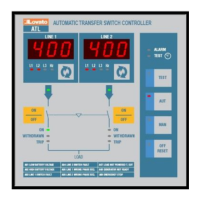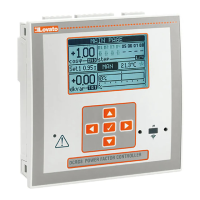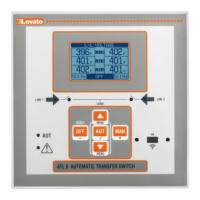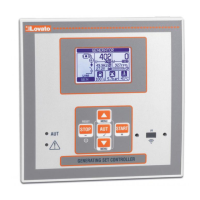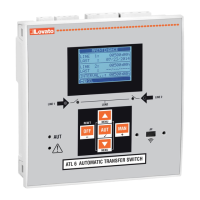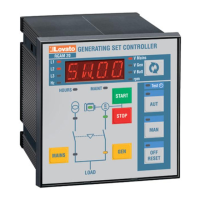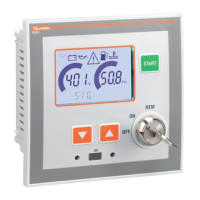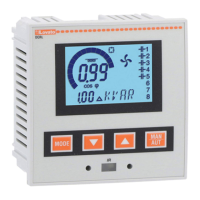Doc: I500GBPL07_19 2020-02-03 p. 29 / 38
zadeklarowana, a sygnał prędkości „W / czujnik” pozostaje
poniżej progu P07.05 przez czas ustawiony w P07.06.
A26 Wysoka prędkość silnika “W /
czujnik”
Występuje, gdy sygnał prędkości „W / czujnik” pozostaje
powyżej progu P07.03 przez czas ustawiony w P07.04.
A27 Wstawiono zębnik
(sygnał zwrotny podczas przerwy)
Alarm generowany, gdy wejście analogowe zębnika
sygnalizuje, że jest ono załączony, ale silnik jeszcze nie
został uruchomiony.
A28 Nie wstawiony zębnik (sprzężenie
zwrotne podczas rozruchu)
podczas uruchamiania
Alarm generowany, gdy wejście analogowe zębnika
sygnalizuje, że jest ono załączony, a silnik został
uruchomiony.
A29 Czujnik zębnika nie podłączony Alarm generowany, gdy wejście analogowe zębnika nie jest
prawidłowo podłączone.
A30 Woda w paliwie Alarm generowany, gdy styk wskazuje obecność wody
w paliwie. Aktywowany przez wejście cyfrowe.
A31 Błąd rozruchu silnika Występuje, gdy po wykonaniu ustawionej liczby prób
rozruchu silnik się nie uruchomił.
A32 Niespodziewane zatrzymanie
silnika
Ten alarm występuje, gdy silnik zatrzymuje się
autonomicznie, po czasie aktywacji alarmu, bez celowego
wyłączenia urządzenia.
A33 Awaria zatrzymania silnika Alarm generowany, jeśli silnik nie zatrzymał się jeszcze po
65 sekundach od rozpoczęcia fazy wyłączania.
A34 Wysokie napięcie akumulatora A Napięcie akumulatora wyższe niż próg ustawiony w P05.04.
A35 Niskie napięcie akumulatora A Napięcie akumulatora niższe niż próg ustawiony za pomocą
P05.03 przez czas dłuższy niż P05.04.
A36 Akumulator A rozładowany Próby rozruchu z akumulatora A wyczerpane z obniżeniem
napięcia akumulatora poniżej minimalnego progu zasilania.
A37 Alarm ładowania akumulatora A Alarm generowany przez wejście zaprogramowane funkcją
alarmu ładowania akumulatora A podłączonego do
zewnętrznej ładowarki akumulatora, gdy napięcie sieciowe
mieści się w dopuszczalnych granicach.
A38 Wysokie napięcie akumulatora B Napięcie akumulatora wyższe niż próg ustawiony w P05.02
przez czas dłuższy niż P05.04.
A39 Niskie napięcie akumulatora B Napięcie akumulatora niższe niż próg ustawiony za pomocą
P05.03 przez czas dłuższy niż P05.04.
A40 Akumulator B rozładowany Próby rozruchu z akumulatora B wyczerpane przy obniżeniu
napięcia akumulatora poniżej minimalnego progu zasilania.
A41 Alarm ładowania akumulatora B Alarm generowany przez wejście zaprogramowane funkcją
alarmu ładowania akumulatora B podłączonego do
zewnętrznej ładowarki akumulatora, gdy napięcie sieciowe
mieści się w dopuszczalnych granicach.
A42 Błąd alternatora ładowarki Występuje, gdy zostanie wykryta praca silnika („W /
czujnik”), ale sygnał alternatora ładowania akumulatora (D
+) pozostaje poniżej progu napięcia silnika uruchomionego
P12.01 przez ponad 4 sekundy.
A43 Zbyt niskie napięcie pomocnicze Napięcie pomocnicze niższe niż próg ustawiony za pomocą
P02.07 przez czas dłuższy niż P02.09.
A44 Zbyt wysokie napięcie
pomocnicze
Napięcie pomocnicze wyższe niż próg ustawiony
za pomocą P02.08 przez czas dłuższy niż P02.09.
A45 Błąd systemu Wystąpił błąd wewnętrzny. Skontaktuj się z naszym działem
obsługi klienta (tel. 71 7979 010; e-mail:
service@LovatoElectric.pl).
A46 Temperatura otoczenia zbyt niska
(czujnik analogowy)
Temperatura otoczenia niższa niż próg alarmowy ustawiony
za pomocą P04.02 przez czas dłuższy niż P04.03.
A47 Temperatura otoczenia zbyt
wysoka (czujnik analogowy)
Temperatura otoczenia powyżej progu alarmowego
ustawionego za pomocą P04.04 przez czas dłuższy niż
P04.05.
A48 Reserwa wody (czujnik cyfrowy) Alarm generowany przez wejście zaprogramowane funkcją
rezerwy wodnej.
A49 Niski poziom wody w cysternie
(czujnik analogowy)
Poziom wody w zbiorniku rezerwowym wody jest niższy niż
próg ustawiony za pomocą P02.16.
A50 Pusta cysterna (czujnik
analogowy)
Poziom wody w zbiorniku rezerwowym wody jest niższy niż
próg ustawiony za pomocą P02.17.
A51 Niski poziom zbiornika zalewania Alarm generowany przez wejście zaprogramowane funkcją
zalewania poziomu w zbiorniku.
A52 Odłączono zasilanie Alarm generowany przez awarię zasilania na zacisku 25.
A54 System nie jest w trybie
automatycznym (przez 24 h)
System nie jest w trybie automatycznym przez ponad 24
godziny.
A55 Wymagana pompa
przeciwpożarowa
Alarm generowany przez wejście zaprogramowane funkcją
Start presostatu.
A56 Pompa przeciwpożarowa nie
pracuje
Alarm generowany przez wejście zaprogramowane funkcją
nieaktywnego przełącznika ciśnienia pompy i pracującym
silniku przez czas ustawiony w parametrze P02.21.
A57 Pompa ciśnieniowa
(przy wyłączonym silniku)
Alarm generowany przez wejście zaprogramowane funkcją
aktywny przełącznik ciśnienia pompy i braku pracy silnika
przez czas ustawiony w parametrze P02.21.
A58 Wymagany serwis 1 Alarm generowany, gdy godziny do serwisu osiągną zero.
Zobacz menu M14. Użyj menu poleceń, aby zresetować
godziny pracy i zresetować alarm.
A59 Wymagany serwis 2
A60 Wymagany serwis 3
A69 Zawór ssący częściowo otwarty Alarm generowany przez wejście zaprogramowane funkcją
„Zawór ssący częściowo otwarty”, w tej sytuacji zawór ssący
nie jest w stanie zapewnić maksymalnego przepływu wody
wymaganego przez pompę silnikową.
A70 Częściowo otwarty zawór tłoczny Alarm generowany przez wejście zaprogramowane funkcją
„Częściowo otwarty zawór tłoczny”, w tej sytuacji zawór
dozujący nie jest w stanie zapewnić maksymalnego
przepływu wody niezbędnego dla instalacji tryskaczowej.
A25 Low engine speed “W / pick-up” It occurs when the motor is in motion (presence of
battery charge alternator), not decelerated, and the 'W /
pick-up' signal remains below the P07.05 threshold for
the time set in P07.06.
A26 High engine speed “W / pick-up” It occurs when the 'W / pick-up' signal remains above the
P07.03 threshold for the time set in P07.04.
A27 Pinion inserted
(Feedback on during pause)
Alarm generated when the analog input signals of the
pinion which is inserted but has not been requested the
starting of the engine.
A28 Pinion not inserted
(Feedback off during cranking)
Alarm generated when the analog input signals of the
pinion which is not inserted but has been requested the
starting of the engine.
A29 Pinion sensor not connected Alarm generated when the pinion analog input is not
properly connected.
A30 Water in the fuel Alarm generated when the contact indicates the
presence of water in the fuel. Activated by digital input.
A31 Engine starting failure It occurs when the engine has not started after the
number of set start attempts has been made.
A32 Unexpected engine stop This alarm occurs when the engine stops automatically
after the alarm time has been set, without the device
intentionally turning it off.
A33 Engine stop failure Alarm generated if the engine has not stopped after 65
seconds from the start of the stop phase.
A34 High battery A voltage Battery voltage higher than the set threshold for a time
longer than P05.04.
A35 Low battery A voltage Battery voltage lower than the set threshold on P05.03
for time a longer than P05.04.
A36 Battery A inefficient
Starting attempts for battery A finished and the battery
voltage is lower than the minimum threshold.
A37 Alarm from battery charger A Alarm generated by the programmed input with the
function ‘Battery charger A alarm’ connected to an
external battery charger when the mains voltage is within
limits.
A38 High battery B voltage Battery voltage B higher than the threshold programmed
on P05.02 for a time longer than P05.04.
A39 Low battery B voltage Battery voltage B lower than the threshold programmed
on P05.03 for a time longer than P05.04.
A40 Battery B inefficient
Starting attempts for battery B finished and the battery
voltage is lower than the minimum threshold.
A41 Alarm from battery charger B Alarm generated by the programmed input with the
function ‘Battery charger B alarm’ connected to an
external battery charger when the mains voltage is within
limits.
A42 Battery charger alternator failure It occurs when the engine is running ('W / pick-UP') but
the battery charge (D +) alternator signal remains below
the motor voltage threshold P12.01 started for more than
4 seconds.
A43 Auxiliary voltage too low Auxiliary voltage lower than the threshold set to P02.07
for a time longer than P02.09.
A44 Auxiliary voltage too high Auxiliary voltage higher than the threshold set with
P02.08 for a time longer than P02.09.
A45 System error There was an internal error. Contact our Customer
Service (Tel. 71 7979 010; e-mail:
service@LovatoElectric.pl).
A46 Room temperature too low
(analog)
Ambient temperature below the alarm threshold set to
P04.02 for more than P04.03.
A47
Room temperature too high
(Analog sensor)
Ambient temperature above the alarm threshold set to
P04.04 for more than P04.05.
A48 Water reserve
(Digital sensor)
Alarm generated by the input programmed with the
‘Water Reserve’ function.
A49 Low water tank level
(Analog sensor)
The water level in the water reservoir tank is below the
threshold set by P02.16.
A50 Water tank emtpy
(Analog sensor)
The water level in the water reservoir tank is below the
threshold set by P02.17.
A51
Low priming tank level
Alarm generated by the input programmed with the
‘Priming tank level’ function.
A52 Outputs power disconnected
Alarm generated by power failure on terminal 25.
A54 System not in automatic mode
(for 24 hours)
System not in automatic mode for more than 24 hours.
A55 Fire pump request Alarm generated by the input programmed with the
‘Pressure switch start’ function.
A56
Fire pump not running Alarm generated by the programmed input with the
function Pump running pressure switch does not active
and motor in motion for more than P02.21.
A57 Pump in pressure (with engine off) Alarm generated by the programmed input with the
function ‘Pump running pressure switch’ active and motor
stopped for more than P02.21.
A58 Maintenance request 1 Alarm generated when the maintenance intervals of its
range reach zero. See menu M14. Use the command
menu to reset the hours and reset the alarm.
A59 Maintenance request 2
A60 Maintenance request 3
A69 Suction valve partially opened Suction valve partially open
Alarm generated by the programmed input with the
function ‘Suction valve partially open’, in this situation the
suction valve is not capable of delivering the maximum
flow rate of water needed to the pump.

